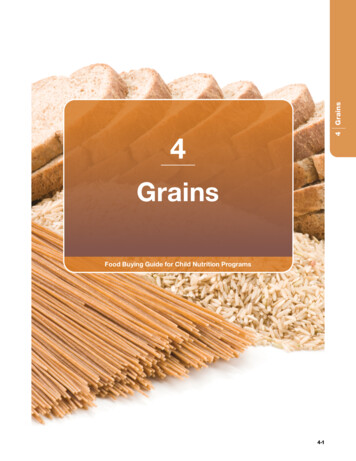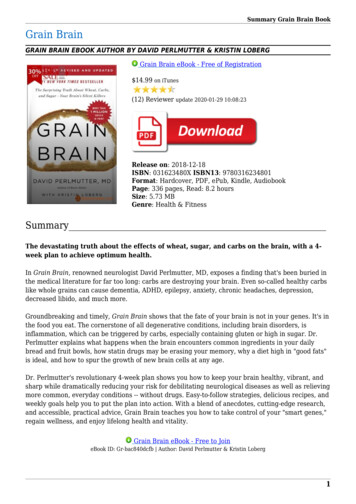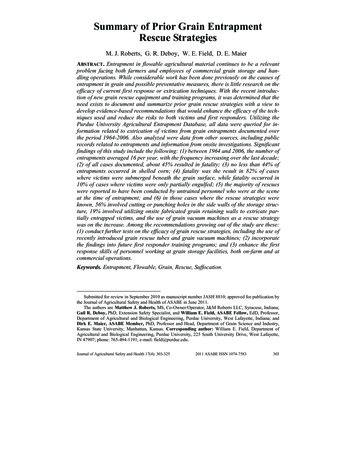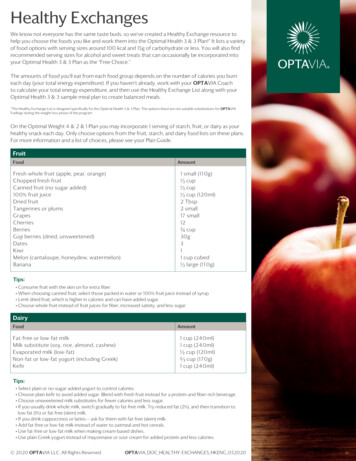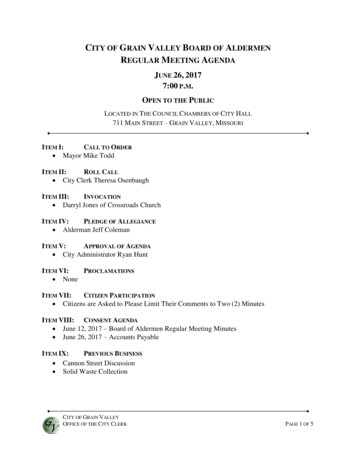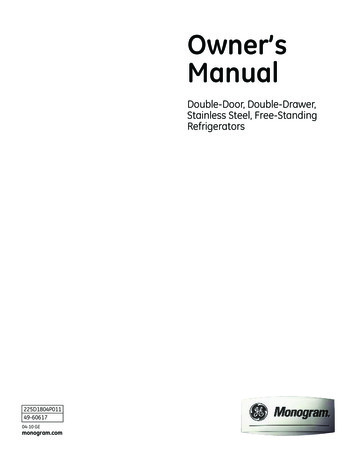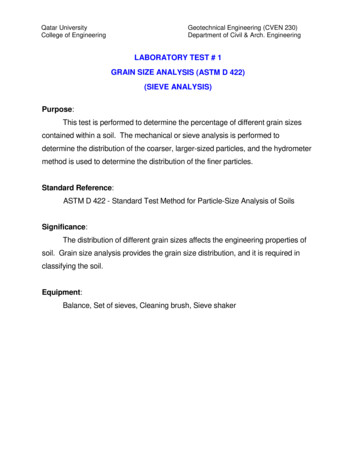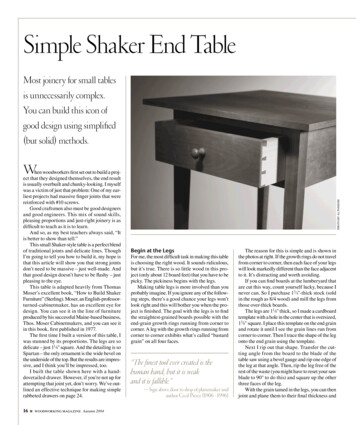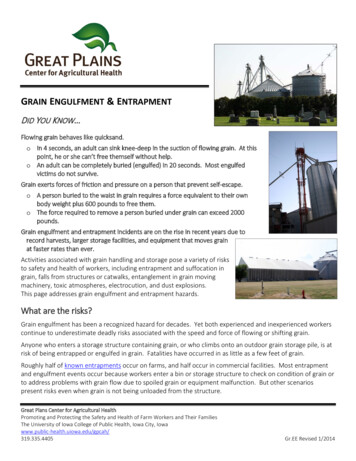
Transcription
GRAIN ENGULFMENT & ENTRAPMENTDID YOU KNOW Flowing grain behaves like quicksand.o In 4 seconds, an adult can sink knee-deep in the suction of flowing grain. At thispoint, he or she can’t free themself without help.o An adult can be completely buried (engulfed) in 20 seconds. Most engulfedvictims do not survive.Grain exerts forces of friction and pressure on a person that prevent self-escape.o A person buried to the waist in grain requires a force equivalent to their ownbody weight plus 600 pounds to free them.o The force required to remove a person buried under grain can exceed 2000pounds.Grain engulfment and entrapment incidents are on the rise in recent years due torecord harvests, larger storage facilities, and equipment that moves grainat faster rates than ever.Activities associated with grain handling and storage pose a variety of risksto safety and health of workers, including entrapment and suffocation ingrain, falls from structures or catwalks, entanglement in grain movingmachinery, toxic atmospheres, electrocution, and dust explosions.This page addresses grain engulfment and entrapment hazards.What are the risks?Grain engulfment has been a recognized hazard for decades. Yet both experienced and inexperienced workerscontinue to underestimate deadly risks associated with the speed and force of flowing or shifting grain.Anyone who enters a storage structure containing grain, or who climbs onto an outdoor grain storage pile, is atrisk of being entrapped or engulfed in grain. Fatalities have occurred in as little as a few feet of grain.Roughly half of known entrapments occur on farms, and half occur in commercial facilities. Most entrapmentand engulfment events occur because workers enter a bin or storage structure to check on condition of grain orto address problems with grain flow due to spoiled grain or equipment malfunction. But other scenariospresent risks even when grain is not being unloaded from the structure.Great Plans Center for Agricultural HealthPromoting and Protecting the Safety and Health of Farm Workers and Their FamiliesThe University of Iowa College of Public Health, Iowa City, Gr.EE Revised 1/2014
Dangerous scenarios1. Flowing grainAround 80% of reported engulfments involve a person inside a bin or storagestructure when grain-unloading equipment is running. Engulfments in flowinggrain also occur in outdoor grain storage piles, grain wagons, rail cars, and semitrailers that unload from the bottom.As unloading conveyors or augers remove grain through the bottom outlet, afunnel-shaped flow develops on the surface of the grain. Anyone standing on thesurface while grain is being removed from below is at risk of being rapidly pulled down toward the outlet in thecolumn of flowing grain. Submersion takes only seconds and once it begins, the pressure and friction forces ofgrain on the body are virtually impossible for victim to overcome. If grain unloading equipment is not shut off,victims can be pulled down into the unloading conveyor, auger, or sump.Victims covered in grain are not likely to survive. Cause of death is usuallyasphyxiation.2. Bridged grainSpoiled or “out-of-condition” grain clumps together and can develop a crust onthe top surface. This crust appears solid, but it is unstable and may hide openvoids below that develop as grain is removed.Bridged grain can collapse under a person’s weight,resulting in the victim being buried by falling andshifting grain. If unloading equipment is running atthe time this occurs, the victim can be rapidlypulled down toward the bottom of the bin.3. Vertical grain wall avalancheSpoiled grain can form a clumped mass that adheres to the vertical wall of a bin.Entering a bin to dislodge a vertical wall of grain that is higher than the victim isdangerous because the grain wall can suddenly break loose and fall like anavalanche, burying or injuring the victim.4. Grain vacuumsSome fatal engulfments have occurred while individuals were using grainvacuums to remove grain from bins. When the grainvacuum nozzle is placed below the grain surface, a funnelflow of grain develops as grain is sucked into the tube. Anoperator can be pulled into the downward flow of grain ifthis nozzle is released or becomes buried below the grainsurface near the operator’s feet.Maneuvering the vacuum tube can be awkward, increasingthe operator’s risk of slipping or losing balance as he tries toreposition the hose in flowing grain. If the operator falls orstruggles for position, his movements can trigger anavalanche of grain if the slope of grain (“angle of repose”) is steep.Great Plans Center for Agricultural HealthGr.EE Revised 1/2014
Prevent engulfmentsTarget: Zero entryThe best ways to prevent engulfment incidents are to eliminate the reasons for entering a bin in the first place,and to restrict unauthorized access by youth or other individuals who may be unaware of hazards.1. Manage grain to prevent spoilage.The most common reason victims enter bins is to addressproblems associated with spoiled grain. Spoiled grain forms solidmasses, crusts, and horizontal grain bridges and vertical grain wallsthat can collapse. Spoiled grain plugs augers and conveyors,necessitating entry into the structure to unplug or free the cloggedequipment. To reduce the likelihood of grain spoilage, Maintain aeration equipment in working order and check thestructure before the storage season to identify and fix roofleaks; and Store grain at the correct moisture content and temperature toprevent conditions favorable for grain to spoil and clumptogether. Aerate to cool grain quickly at the time of storage,remove the core of fines that is most prone to spoilage, andmonitor for pests, off-odors, hot spots, and moisture contentto help prevent spoilage.2. Work from outside the bin.If clumps or crusts develop in the grain, use a pole from outside thebin to probe or knock the clump free.3. Restrict access to bins, storage structures, and outdoor grainstorage piles.Post signage and lock access doors so unauthorized persons, bystanders, andyouth cannot enter.4. Post signage warning of hazards.Post signage at all entry points to bins, outdoor storage piles, and other storagestructures that warns of potential for engulfment and requires any entry to be done by trained workers following safe tmlGreat Plans Center for Agricultural HealthGr.EE Revised 1/2014
Plan ahead for occasions when entry is absolutely necessary1. Provide training.Train workers on grain storage hazards and risks involvedwith entering a grain storage bin or facility. Training shouldinclude recognizing grain quality problems, entry procedures,use of safety equipment, and emergency response, beforeallowing access to a bin or storage structure. Training shouldbe provided at regular intervals, not just upon hiring or oncea year.2. Have an emergency rescue plan in place and follow it.The plan should include having cell phones on site,emergency numbers posted for local emergency responders trained in bin rescue, and prevention of untrained“would-be rescuers” who could increase grain pressure on a victim or even become engulfed themselves.3. Shut down all grain loading and unloading equipment (turnheads, reclaim conveyors, augers) and lock out thepower sources to them.If mechanical and pneumatic grain moving equipment cannot belocked out, do not enter.4. Evaluate the atmosphere.Use a gas meter to check for adequate oxygen content in the bin andthe presence of toxic gases like carbon monoxide (which can bepresent if there is combustion or smoldering grain), fumigants, orexcessive carbon dioxide.If the air in the bin smells like spoiled or moldy grain, assume thereare dangerous bridges or vertical grain walls that can collapse.If grain is out of condition, or the atmosphere conditions cannot bedetermined, do not enter.Atmosphere checklistDo not enter if:Oxygen level 19.5%or 23.5%Carbon monoxide 25 ppmToxic gases:Hydrogen sulfide 10 ppmPhosphine 0.3 ppmOdorsspoiled grain,chemicals,orsmoldering/ burningodors are detectedDustVision is obscured to 5 feet5. Turn on aeration fans.6. Visually inspect the interior of the structure before entering.A grain wall can collapse or a high slope of grain can shift suddenly, burying the entrant.Never enter a bin where the upper level of grain along the wall is above the entrant’s position inside; if grain is hung up on a side wall; or if the angle of stored grain exceeds the angle of repose.7. Never enter alone.Two outside observers must be present to monitor entry and assist by regulating a lifeline tether.One attendant must maintain constant visual monitoring of the entrant and have a system of communicationworked out before entry (hand signals).Great Plans Center for Agricultural HealthGr.EE Revised 1/2014
8. Use fall restraint equipment that is properly anchored.This consists of a full body harnessattached to an anchored line, and limitsthe distance the entrant can drop or fallin the event that grain shifts or a grainbridge collapses beneath the entrant.The lifeline must be secured to a sidewallanchor (not the interior ladder) or a fixedpoint outside the bin to prevent theentrant from sinking more than waistdeep into grain. One attendant monitorsthe feed of the lifeline to the entrant.9. Never allow others that have not beentrained in the steps above to enter a bin.10. Remember that youth under the age of 16 cannot be employed to work inside a confined space; this includesgrain storage structures.Great Plans Center for Agricultural HealthGr.EE Revised 1/2014
For more informationVideos and multimediaGrain Bin Entrapments.A 51-minute radio program broadcast August 13, 2013 on the Illinois Public Media program “Focus”. will am -bin-entrapmentsGrain Bin Safety.A 17-minute YouTube video with explanation of scenarios resulting in grain engulfment hazards in storagestructures, grain management to prevent conditions requiring entry of storage facilities, requirements that mustbe in place if entry must be conducted, and guidelines for managers to protect employees. Other grain safetyhazards are also briefly discussed. Produced by Oklahoma State University Division of Agricultural Sciences andNatural Resources Stored Products Research and Education Center. 2011.http://www.youtube.com/watch?v DQSqWbn-3X0Buried in Grain.A special series investigation by National Public Radio and the Center for Public Integrity examining the danger andweak regulatory response of grain bin entrapments. -grainGrain Bin Safety.A 13-minute YouTube video produced by the National Corn Growers Association and the National Grain and FeedFoundation describing Illinois grain engulfment fatalities involving teenagers that occurred in 2011.http://www.youtube.com/watch?v YDwJCdjlZYE&feature youtu.beSafe Grain Bin Entry.A PowerPoint presentation by Georgia Tech Research Institute on safe entry techniques and permit ptFor information on training in your area, contact: Grain Handling Safety Coalition. http://grainsafety.org The National Education Center for Agricultural Safety (NECAS). www.necasag.orgGreat Plans Center for Agricultural HealthGr.EE Revised 1/2014
ArticlesYou Can Die in a Grain Bin in Less Than 60 Seconds. (Work in Progress) The Official Blog of the US Department of Labor. rain-bin-in-less-than-60-seconds/OSHA’s Grain Handling Safety Website. Entrapment Risk due to Flowing Grain. Farm and Ranch eXtension in Safety and Health (FReSH) Community of Practice. nt-risk-due-to-flowing-grain#.UuGfMhBMH0OGrain bin danger – just 20 seconds to entrapment. Delta Farm Press. 2013. t-20-seconds-entrapmentSuffocation Hazards in Grain Bins. University of Arkansas Division of Agriculture, Publication FSA1010.http://www.uaex.edu/Other Areas/publications/PDF/FSA-1010.pdfGrain Engulfment in Agricultural Operations. University of Minnesota Injury Prevention Project, PubH 6120. gement of Stored Grain with Aeration. University of Minnesota Extension Publication WW-01327. psystems/dc1327.htmlBuried Alive: Grain Suffocation Hazards. A publication of the Loss Control Education Unit and Public Relations Department ofNorth Dakota Workers Compensation. 2002. rain Bin Safety Resources. Oklahoma State University Extension Stored Products Research and Education Center tmlGrain Bin Entrapment: What if it Happens to You? A case study from an Oklahoma county elevator. Oklahoma State UniversityCooperative Extension Service, Publication CR-1726.http://www.google.com/url?sa t&rct j&q &esrc s&source web&cd 1&cad rja&ved 0CCYQFjAA&url dsweb%2FGet%2FDocument-2207%2FCR1726web.pdf&ei oKPhUpTvFsPt2QWx6ICgBQ&usg AFQjCNFmGx0ynkUL6F5r--DKJlNIJCrFiQ&bvm bv.59930103,d.b2IHazards of Flowing Grain. Penn State Extension, Publication E 43. 2013. ently asked questions about flowing grain entrapment, grain rescue and strategies, and grain entrapment preventionmeasures. Purdue University Cooperative Extension Service. inEntrapments.pdfAnnual Summaries of Grain Entrapment in the United States. Purdue University. ex.php?page pubs/safety.phpSafety During Grain Handling, Drying and Storage. Extension publications from Purdue University Post Harvest Grain Quality &Stored Product Protection Program. p?page pubs/safety.phpNIOSH FACE Program. To search for fatality case investigations involving grain engulfment, use the “search” box and type in keywords. http://www.cdc.gov/niosh/face/Fatality investigations involving grain vacuums include: 12IA001, 09IA012, 98IA035, 93MN007.Prevent fatalities from grain entrapment. Iowa FACE Program Hazard Alert 10-2011. Alert.pdfPromoting and Protecting the Safety and Health of Farm Workers and Their FamiliesThis publication was supported by Cooperative Agreement Number U54 OH007548 from CDC-NIOSH through an award to the Great PlainsCenter for Agricultural Health. Its contents are solely the responsibility of the authors and do not necessarily represent the views of the CDCNIOSH.
1. Provide training. Train workers on grain storage hazards and risks involved with entering a grain storage bin or facility. Training should include recognizing grain quality problems, entry procedures, use of safety equipment, and emergency response, before allowing access to a bin or storage structure. Training should
